Fetish
 A fetish is an object believed to have unusual powers, and fetishism is the practice of regularly believing in the power of these objects. For example, a person might ascribe supernatural powers to a carving and carry it around in his or her pocket for protection. In psychology, fetishism typically refers to sexual fetishism, in which a person gets sexual gratification solely or primarily through unusual sexual practices or the use or admiration of objects or body parts not typically associated with sex.
A fetish is an object believed to have unusual powers, and fetishism is the practice of regularly believing in the power of these objects. For example, a person might ascribe supernatural powers to a carving and carry it around in his or her pocket for protection. In psychology, fetishism typically refers to sexual fetishism, in which a person gets sexual gratification solely or primarily through unusual sexual practices or the use or admiration of objects or body parts not typically associated with sex.
Examples of Fetishism
In sexual fetishes, the object or situation that is arousing is the fetish, while the person receiving arousal is a fetishist. The practice of receiving arousal from a specific object or situation is fetishism. Fetishes are diverse and can include a wide variety of sexual practices, some of which are more common than others. Some fetishists are simply aroused by fetishes, while others can obtain arousal solely from their fetishes. A few examples include:
- Foot fetishes – This is one of the most common sexual fetishes, particularly among men. Fetishists may be aroused by the sight of feet, enjoy licking, sucking, or touching feet, or may even wish to engage in sexual acts with feet.
- BDSM – This is a situational fetish, in which a person enjoys power exchanges involving bondage, domination, discipline, submission, or sado-masochism. BDSM is a common fetish. The fictional book 50 Shades of Grey, a best-seller, explores the exploits of a BDSM fetishist.
- Animal fetishes – Some people are aroused by certain animals and may even practice beastiality. Others enjoy dressing up as animals or having others pretend to be animals. Furries are a variation of these fetishes, who dress up in large, plush animal costumes. Furry groups have large conferences, and are a common source of internet jokes, memes, and derision.
What Causes Fetishes?
Mental health practitioners have debated the causes of fetishes for generations. Practitioners used to believe that fetishes were conditioned by early experiences or the result of trauma, but now beliefs differ widely. Some practitioners believe that fetishes are random and not caused by any specific thing; they may just be variations in the sexual continuum.
Is There Treatment for Fetishism?
Fetishes do not warrant treatment unless they cause the fetishist or those around them discomfort or anguish. Treatment may involve reconditioning the fetishist to enjoy other sexual objects, discussing the causes of the fetish, behavioral modification, or aversion therapy.
Some interest groups have lobbied against the stigmatization of fetishism, and there are a wide variety of groups advocating the acceptance of various fetishes online.
References:
- American Psychological Association. APA concise dictionary of psychology. Washington, DC: American Psychological Association, 2009. Print.
- Colman, A. M. (2006). Oxford dictionary of psychology. New York, NY: Oxford University Press.
Last Updated: 08-7-2015
- 24 comments
- Leave a Comment
javad
March 8th, 2016 at 12:58 AMHi
Is foot fetish and mistress/slave desire curable completely?best regardsChristina J
June 21st, 2016 at 4:59 AMHey I am 20 years old I just got in a relationship with a 40 year old man who had his ex-wife they had a bsdm relationship and now that’s what he wants from me because he’s got his supposed to leave they told her to hurt him that’s the trouble I’m having right now how can I physically hurt him during great intercourse?
Scott L
August 12th, 2016 at 7:08 PMHi I am a guy who has a fetish that has been with me for yrs now. I absolutely love to wear woman’s underwear and stuff.
Leave a Comment
By commenting you acknowledge acceptance of GoodTherapy.org's Terms and Conditions of Use.
